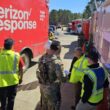At MWC, AT&T and AST execs talk up space-based possibilities
MWC24 – BARCELONA – The wireless industry’s space race increasingly looks like a two-company contest between AT&T, partnering with AST SpaceMobile, and T-Mobile, linked up with SpaceX’s Starlink.
The latter effort has gotten much more attention, thanks to Starlink’s enormous constellation of satellites that now includes direct-to-cell versions and also to Elon Musk’s outsized, no-inner-monologue presence on X. During MWC, Musk posted onto X via Starlink’s direct-to-cell service.
But in conversations at AT&T’s booth here, AT&T and AST executives professed confidence in their quieter quest to make satellite connectivity a commercial reality.
Watch this space
“2024 is going to be a really important year,” said JR Wilson, AT&T’s vice president of tower strategy and roaming. “It’s going to be a year of really extensive testing and really beginning to finalize the commercial model and the go-to-market strategy.”
AST, meanwhile, is looking forward to the launch of its first five BlueBird satellites, higher-capacity successors to the BlueWalker 3 satellite it has used for tests of voice and data service.
“We’ll be launching five satellites in Q2 which will allow us to offer some initial services,” said Scott Wisniewski, executive vice president and chief strategy officer for the Midland, Texas, firm. “Initial” means availability is limited to when any one of those satellites is overhead, not slower service.
(Those launches, like the 2022 delivery of BlueWalker 3, have all used SpaceX rockets, a reflection of that company’s dominance of the launch market.)
AST says it needs five satellites to start providing service, with 90 constituting a full deployment – a tiny fraction of the 5,000-plus Starlinks now in orbit. Wilson said AT&T picked AST because of the much higher capacity and power of its satellites.
“If AST is launching the largest antenna array, you could think of it like they’re launching school buses,” he said. “And maybe another satellite provider who’s having to launch lots of birds, they’re launching Mini Coopers. And you need a lot of Mini Coopers to be able to do the same thing that the school bus does.”
Wisniewski then emphasized how much more capacity each new generation of AST satellites will have compared to BlueWalker 3’s 100MHz.
“The satellites we’re launching in Q2 have a thousand megahertz of capacity,” he said, while next-generation satellites will include a custom ASIC “that we’ve been working on for about four years” and other improvements that will support up to 2,000MHz of capacity.
Wisniewski said 45 satellites would provide enough coverage over the US for “a true consumer service,” with the next 45 covering the rest of the globe.
To read the complete article, visit Light Reading.

















